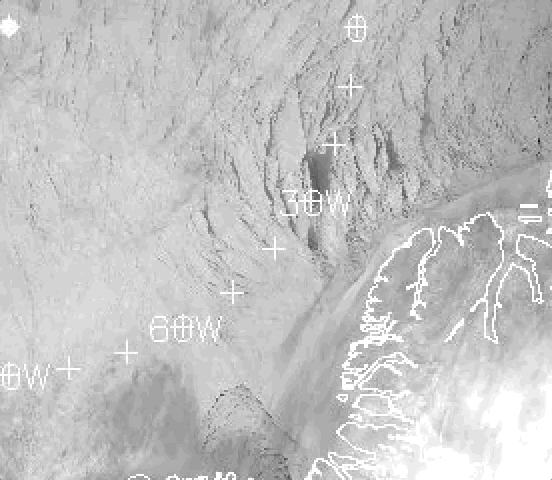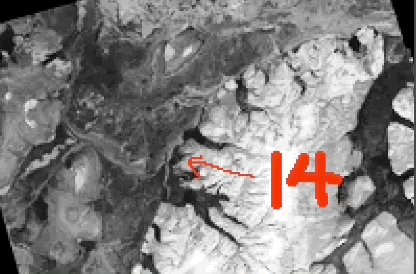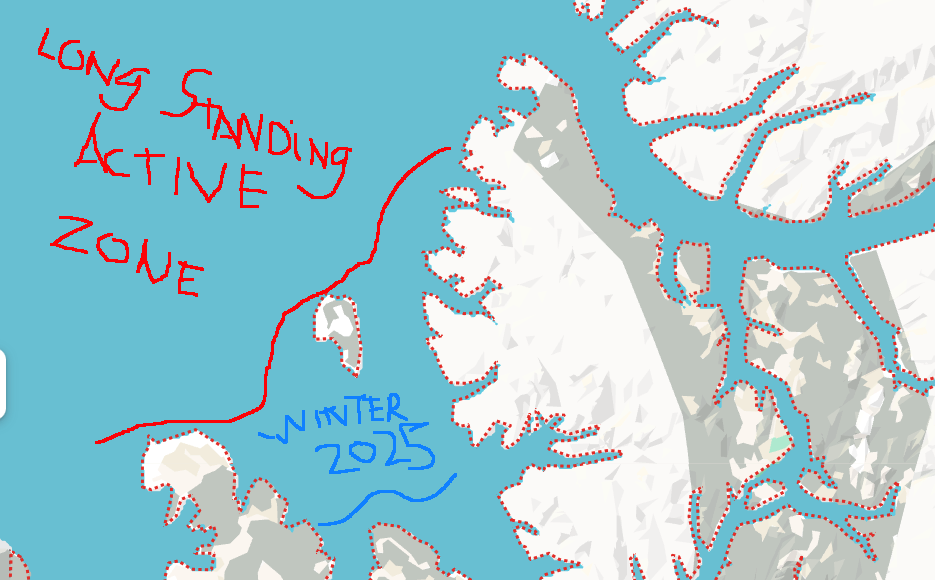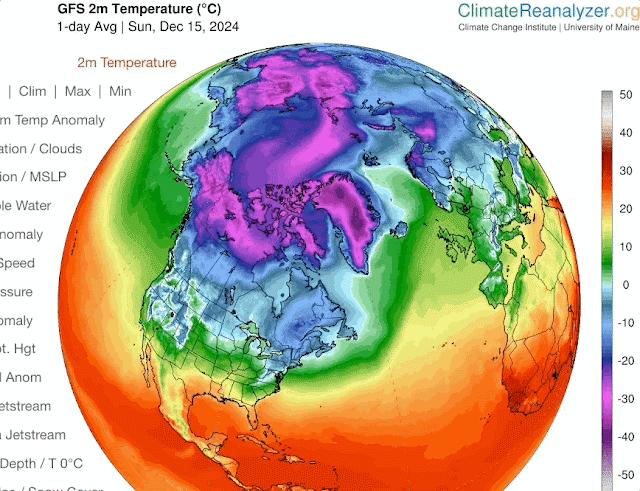-Actively looking for refraction effects, especially from street lights, inconclusive from yet good video evidence. The flight paths of both aircraft was captured pretty well, because of fixed mount of camera. The jet was descending slowly, while the helicopter appears to have changed altitude directions twice.
Friday, January 31, 2025
Potomac crash flight paths, and background refraction
-Actively looking for refraction effects, especially from street lights, inconclusive from yet good video evidence. The flight paths of both aircraft was captured pretty well, because of fixed mount of camera. The jet was descending slowly, while the helicopter appears to have changed altitude directions twice.
Tuesday, January 28, 2025
Never seen before series; this time great Arctic Ocean low cloud wave
~As far as I can remember (with satellite photos observed since 1985), never seen such a wave of low altitude warm clouds of this magnitude in January :
NOAA Infrared HRPT loop, January 27 to 28 2025. Massive low cloud wave, in black, since it is warm, coming from the North Atlantic, covering about 1/4 of the Arctic Ocean in about 1 day.and a half. Usually these were seen in narrower streaks. between Anticyclones and Low pressure systems. I do not recall seeing such a wave being so expansive. Note Greenland dryer air area of influence. There is a High pressure system on theNorth Pole to Siberia quadrant. WD January 28, 2025
Friday, January 24, 2025
More Never seen before sea ice events; the "big lead triples", and wide openings North of Greenland in January
~These are absolutely clear signs of a different Arctic winter sea icescape.
NOAA HRPT infrared picture, January 24 2025. There are 2 "big leads" quite distant from Canadian Archipelago shore,. These are mostly tide constructs along with winds. The "big lead" use to be a controversial subject originally described by the early North Pole explorers, the likes of Peary and Doctor Cook some 120 years ago. The advent of Polar orbiting satellites proved them right. But the traditional "big lead" usually formed NW along side right near the archipelago. Now there are 2 more of them...Next Extraordinary appearance of wide open water, North of Greenland:
A remarkable, extraordinary NOAA Infrared HRPT , January 16 opening seen where usually only thin leads occurred, there is a water sky, on the East side of the opening from an open water source. North of Greenland ocean is where sea ice is pushed outwards to the East and South aided by tides. All kinds of activity happens there, numerous North South thin leads were the main features, indicating pack lice breaking up. But these where only on Greenland extreme NE shoreline, the break zone now extends much further westwards On Radarsat it looks even more chaotic:
North of Greenland January 15 and 24, 24 has many more dark openings especially on the coast line... Very strange, never seen midwinter event. Again signalling a more fragile and overall thinner sea ice, breaking up wider more easily because it is less dense. WD January 24 2025
Thursday, January 16, 2025
Canadian Arctic Archipelago Arctic Ocean significant Tidal Zone moved South
~The active Arctic Ocean open water tidal zone moved 170 Km Southwards in 2025
 Just North of Amund Ringnes, circled in red, is an active Tide Zone , as of January 14 2025, way South of where it use to be.
Just North of Amund Ringnes, circled in red, is an active Tide Zone , as of January 14 2025, way South of where it use to be. Tuesday, January 7, 2025
EAST Hudson Bay wide area boating season January 5 2025
~A current live event for Anthropogenic enhanced Global Warming.
~ Following up from this EH2r article: "https://eh2r.blogspot.com/2024/12/hudson-bay-revisit-wide-open-water.html
JAXA University of Bremen Sea ice extent , Hudson Bay complete freeze-up will be very late this season, a wide open boating season continues far off the entire East Coast.. As of January 5.
"Freeze-up begins along the northern shore in September and gradually ex- tends southwards and eastwards. In the southeast, freeze-up occurs last, typically around the first of January. " Eric Danielson Jr U. Of Calgary:
From Sven Sungaard an important Graph:
"0"
Nothing! Apparently no sea ice.It is 19 days later than November 12 when a thin sliver of sea ice appears this season.....
Recent world wide warmest years in history had 100% coverage mainly around Christmas. Current Hudson Bay complete freeze up awaits a date. WD January 7 2025
Monday, January 6, 2025
Never seen before redux, this time just North of Amund Ringnes Island
Very rarely mentioned, nor frequented, Amun Ringnes Island fame occurred long ago when it was first discovered in 1900 by Otto Sverdrup a Norwegian explorer.
Just to its North a Tidal lead which opened about a week ago:
Onto itself, Arctic sea ice Archipelago channel wide tidal leads are more frequent in the spring to fall, not in January, very few occur nearly year round, they are mainly caused by strong tidal currents. Detected by NOAA Polar Orbiting Jan 1 2025 high res satellite. This Amund Ringnes never seen in January event, is merely an extension of the Arctic Ocean lack of thick or ridged sea ice in the not so long ago past assuring a winter permanent presence of ice at the same location, there was no such wide openings possible.Wednesday, December 25, 2024
Hudson Bay revisit, wide open water Eastern quadrant, less cloud effect.
~Surreal open water end of December, Hudson Bay illustrates Earth Warming fast
JAXA Dec 23 comparison , sea ice extent, 2012, 2016, 2023, 2024 ; respectively year of:warmest sea ice melt in history, 2016 very powerful El-Nino, last year middle of a milder El-Nino than 2016 , current December 23 (2024).It is fair to say 2012 greatest sea ice melt in history would take longer to recover, it is equally succinct to demonstrate warmest El-Nino effects should be bad for sea ice in 2016, Hudson Bay started to show even slower refreeze in 2023, but 2024 surpasses them all:
December 23 2024, incredible certainly for the people living on Hudson Bay Eastern shores.Sea water usually doesn't freeze at -1 C unless 2 m air temperatures are about -11 C or colder, in especially calm winds:
CMC 0 C degree sea surface temperature line way North.
Albedo caused by near 0 degree Centigrade fog and clouds gracefully slow down Arctic Ocean sea ice melting totally during summer. Hudson Bay gets less of this happenstance because it is surrounded by land, once upon a time more frozen for a long period of the year. Not anymore, since mainly from the West air circulating over drier vast lands eventually sheds its total moisture content, causing more over all sunshine. Equally these lesser clouds over H.B. bombards its sea water to be warmer, the surrounding lands likewise.
The lesson here is that faced with a lesser cloud summer event, the Arctic Ocean sea ice would pretty much easily disappear at extent minima. Hudson Bay total sea ice cover, once a beginning of December event, now moves forward into winter not as fiercely cold as it was just a few years ago. WD December 25, 2024.
Sunday, December 15, 2024
Enormous heat from thinner sea ice blunts and deforms world wide winter circulation
~We look at the source of strange weather holistically, but in particular where it is more perturbed.
~Hurricane like heat injects into the Arctic fall and early winter atmosphere simply because Arctic sea ice is thinner.
O.5 meters of sea ice, spanning a huge area gives off close to 100 Watts/m2 heat into the Arctic Ocean atmosphere directly above, in total darkness, compare this to CO2 contribution of 4 Watts/m2, consider this warming giving a glimpse of things to come. Remember Nansen reported 3 meters thickness, this capped the Arctic ocean heat transfer almost completely then.
What does this heat injection do?:
U of Maine Climate Reanalyzer, thinner Arctic sea ice heat injection to the atmosphere, literally shows up almost every day as a warming directly into Polar darkness. Making a definite very strong contribution to 2 m surface warming. In turn, the alteration of sea icescape thickness modifies planetary waves morphology, these are Polar Vortex contortions, greatly affecting weather everywhere onto the warming caused extremes everyone experiences. WD December 15 2024
Wednesday, December 4, 2024
Thinning sea ice looks like no other time, but extent results don't show it
~ Amazing degradation of sea ice tidal ridging zone in one year
This was the sea ice picture of 2023-24, the freezing in place of new sea ice, a huge area, not destroyed by daily tidal ridging, the black area North of Axel Heiberg Island (the Island with Fjords at right)
December 23 2023 Polar View High Resolution image of a huge area of sea ice lasting all winter. A first in the corrupted by AGW Arctic Ocean sea ice. Although winter 2024-25 has not as large fast thin ice area at freeze up, over all sea ice condition is worse in a vaster expanse: Same area onset of winter freeze, December 3 2024, but there is an even greater cumulative area of thinner and broken up sea ice, giving a loose pack ice look North of NW Canadian Archipelago Islands. This is a view of the last stand of Arctic Ocean summer sea ice, before there are none in summer, what is left of the thickest sea ice is badly broken up. I suspect that next December 2025 will look even more grim. This area has great tides from The Northwest, ensuring ridging or the thickening sea ice by the sheer weight of massive sea ice folding ice sheets on top of each other, but if the greater Arctic Ocean pack ice is equally thinner the ridging mega push looses strength as was the case for winter 2023-24 Heat radiation gained to the atmosphere by much depleted, thinned Arctic Ocean sea ice is enormous. This significant feature will reduce the shape and extent of the coldest Northern Atmosphere (The Polar Vortex) during winter will affect the climate of every Northern Hemisphere location. WD December 4 2024Sunday, December 1, 2024
Abnormal beyond model warming; One big reason: Slower moving circulation caused by vanishing thinning Arctic sea ice
~Interesting article by GSC Gavin Schmidt, a must read: https://www.nytimes.com/2024/11/13/opinion/climate-change-heat-planet.html
~Most can be indirectly understood if you read my latest of many similar yearly April climate Projections for the summer fall:
https://eh2r.blogspot.com/2024/04/2024-summer-fall-projection-forecast.html
The reason why the warming is greater for the Northern Hemisphere is simple, Arctic sea ice reduction in area and thickness surrounded by continents. For this we must look at NASA GISS:
Annual mean Land-Ocean Temperature Index in 0.01 degrees Celsius
selected zonal means
--------------------
sources: GHCN-v4 1880-10/2024 + SST: ERSST v5 1880-10/2024
using elimination of outliers and homogeneity adjustment Note: ***** = missing - base period: 1951-1980
24N 24S 90S 64N 44N 24N EQU 24S 44S 64S 90S Year Glob NHem SHem -90N -24N -24S -90N -64N -44N -24N -EQU -24S -44S -64S Year 2021 85 114 55 143 65 53 206 136 127 72 58 72 33 30 2021 2022 89 116 62 152 56 70 235 150 127 62 51 78 40 108 2022 2023 117 150 85 178 106 71 258 187 147 108 105 90 45 62 2023 Year Glob NHem SHem 24N 24S 90S 64N 44N 24N EQU 24S 44S 64S 90S Year -90N -24N -24S -90N -64N -44N -24N -EQU -24S -44S -64SThe zonal mean 64-90 North and South says it all. There is a continent wide Glacier at the South Pole, while at the North Pole there is a continent size Ocean covered by sea ice. If this sea ice vanishes, something likely to happen during a coming summer, temperatures at North Pole Region would warm much more. At the moment, the warming is gradual but close to 4 times faster compared to the Antarctic.A slowing of global circulation is a symptom of massive temperature differentiation from one temperature zone to the next, as the Arctic sea ice disappears so will the Northern Hemisphere swift weather events usually lasting a day or so, temperatures between the North Pole and Equator will be significantly less, engendering slow to sluggish circulations causing catastrophic events to linger, such as Typhoon/Hurricanes moving slowly over a populated area, as already happened. Causing entire regions languishing under same weather conditions for days or much longer, such as excessive droughts, never ending heavy rain periods as has happening more recently again.July peak record breaking temperatures way above climate model projections (NYtimes article) is an indication confirming that Northern Hemisphere is warming faster than the South, largely tempered by massive Oceans and said huge Antarctic Glacier. There is ample evidence of Arctic sea ice changes, suffices to say, its state is nowhere similar compared with a mere 20 years ago. Especially autumn and winter ice topography, recently more broken and with open water, along with the warmed Oceans have caused our present delay of onset of winter worldwide. WD December 1 2024

























